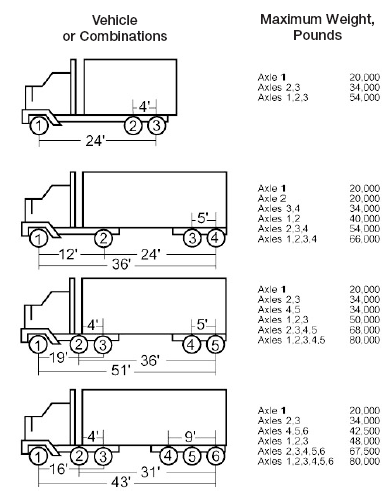Simplify Your Oversize/Overweight Loads
- Instantly Determine Permit & Escort Costs
- Calculate Max Legal/Permitted Axle Weights
- Understand Equipment Limits
Axle Weight Calculator | Steer, Drive, Single, Tandem, Tridem Axle Load Legal And Permitted Weight
Quick Navigation:
Why axle weight limits exist
In 2018 the state and local governments of the United States spent more than 187 billion dollars on highways and bridges making it the 5th largest expense. 44 percent of this funding was dedicated to maintenance, while the other 56% was dedicated to the actual construction of the roads and highways [1]
Most damage to roads and bridges is done by heavy vehicles. The reason is that as the weight of the axle goes up, the damage done to the road surface does not go up linearly, but goes up by a factor of four. That is, going from a 1 ton axle to a 5 ton axle will do 625 times more damage to the road surface. That is why the gross and axle weight limits exist and are strictly enforced.

Why axle weight limits are important to truckers
The simplest answer is giant fines. Fixing roads is a huge expense to the state, so they will transfer that expense to you. If you get caught overweight on an axle, gross vehicle weight, or worse haven’t purchased an overweight permit, the consequences can be devastating.
The fines for a grossly overweight vehicle can reach tens of thousands of dollars, and when a fine is levied for an overweight condition, it is the driver who will be cited and have that citation on his driving record. Most states will also add court costs that may double the total cost of the fine. You can see an overview of overweight fines by state here.
Additionally most states classify violation of overweight limits as a misdemeanor, and while not a felony, may be punishable by periods of probation, community service, and/or jail time that may be weeks, part time, and up to a year. Also mind that trying to get around the limits by falsifying the weights on your overweight permit may be a felony.
Consequently, it is important that both drivers and dispatchers understand truck loading and weight limits for axles and axle groups even before accepting the load.
Those weights vary from state to state, and it is not as simple as total vehicle gross weight or 20,000 per axle, a lot of variables go into determining maximum allowed weight. They are quite complex and will require time to understand, but you have to understand them one way or another, hopefully before getting a violation on your record and paying thousands of dollars in fines.
How axle weight limits are determined

Manufacturers Axle Rating
You can’t carry more than your equipment can handle. Both your truck and your trailer should have a manufacturer’s rating posted on them. Make sure to keep the weight under those limits. Mind that just because your equipment can handle the weight does not mean the states will allow you to carry it.
Manufacturers Tire Rating
Same as above, do not carry more than your tire manufacturer's rating allows.
Axle Weight Limits
There are two limits you have to consider, max legal and max permitted.
Maximum Legal Axle Weight is the weight under which you can move without purchasing permit, e.g. anything under the federal bridge formula or the state legal axle limit (state limits are often higher than the federal ones).
Max Permitted Axle Weight is the weight above which the state will not allow you to move even with a permit.
Always make sure to know both of those limits for the states you are going through.
Federal Limits

There is only a federal regulation for the maximum legal weight, the federal government does not issue overviewght permits, so they do not provide maximum permitted limits, those are determined by each individual state.
The federal limits you need to know are:
- Federal Bridge Formula. You can read about it and use the federal bridge calculator here.
- Maximum legal gross and axle weight limits. In addition to Bridge Formula weight limits, Federal law states that single axles are limited to 20,000 pounds, and axles spaced more than 40 inches and not more than 96 inches apart (tandem axles) are limited to 34,000 pounds. Gross vehicle weight is limited to 80,000 pounds (23 U.S.C. 127).
Almost everything else you need to know are the state level regulations.
State Axle Weight Limits
State limits are the most important ones, as these will determine how much and if you can move within that state.
Again, there are two numbers you need to know, the maximum legal and maximum permitted weight.
When you know those two numbers, you'll have three ranges, for example for Texas, maximum legal weight on a tandem is 34,000 pounds and maximum permitted weight is 46,000 pounds. That is, you can load your tandem up to 34,000 without purchasing a permit, you can load 34,000..46,000 with a permit, and if your tandem is loaded over 46,000 you cannot legally enter the state of Texas.
Note, generally the states will not issue overweight permits for divisble loads. That is, even though you can technically have up to 46,000 pounds on a tandem if you purchase a permit, most states will not issue that permit if you can simply unload the excess weight (e.g. you are transporting sand or gravel). The overweight permits are for non-divisible loads, for example a piece of machinery that cannot easily be disassembled to reduce it's weight. There are of course exception and special permits for divisible loads, you have to consult that with the state.
Maximum legal weight limit
Maximum legal weight for each axle is determined by the federal bridge formula, federal limits for a single axle and axle groups (mentioned above) and single axle and axle groups legal limits posted by each state. (State limits are often higher than the federal limits).
Maximum permitted weight limit
Multiple things go towards calculating the maximum permitted weight for an axle or an axle group.
Two of the most important things for determining max permitted weight are: #1) tire weight limit and #2) single axle and axle group limit. You have to know both limits, and whichever is the lesser limit is the one that will determine your max permitted weight.
#1 Tire Weight Limit
Tire Width
You cannot exceed tire rating or state posted limit for the max load on a tire, for example in some state it is 650 pounds per inch of tire width. Many states have different limits and some states have different tire weight limits for steer axles.
Number Of Tires
The more tires you have, the higher is your weight limit for that axle based on the tire weight rating, as you’ll be multiplying the tire weight limit * tire width * number of tires
#2 Axle and Axle Group Limits
Every state has limits for a max single axle and each axle group weights.
Axles in the axle groups are almost always given a lower weight per axle than if they were single axles, e.g. a single axle in texas can carry 25,000 pounds, but a tandem (two axles in a group) can only carry 46,000 pounds, so 23,000 per individual axle in that tandem.
The axles or axle groups are:
Steer Axle: The steer axle provides directional control through the driver’s steering wheel, it's usually the first axle with only a single tire on each side, so it is almost always limited by the tire weight limit and can carry a much lower weight. You can get more weight by putting a wider tire on the steer, but overloading the steer makes steering harder.
 Example of a steer axle
Example of a steer axleSingle Axle: Single axle is an axle spaced enough apart from other axles to not be considered to be in a group

Example single axle on a booster
Tandem Axle: A tandem axle describes two axles spaced more than 40” but not exceeding a certain limit that is different in many states. Distances are measured from the centers of the two axles. Note: two axles spaced less than 40 inches apart are considered a single axle. Tandem axles may be drive axles.

Example tandem on a lowboy trailer
Tridem Axle: A tridem axle is made up of three consecutive axles spaced within a state posted limit of each other

Example tridem on an rgn
Quad Axle: A quad axle is made up of four consecutive axles spaced within a state posted limit of each other

Example quad axle on an extendable step deck trailer
Note: Axle groups of five and more axles may be used when hauling certain loads. These are uncommon special cases and not all states specify weight limits for five and over axle groups.
Axle Spacings
Axle groups above are determined based on the distance between the axles and are different in many states. Sliding axles apart will give you a higher weight.
Axle Type
Some states consider steer and drive axles as a different type of axle and will give you a higher or a lower limit on them. For example many states will give you a different tire weight rating for the steer.
Always make sure to check if there is a different steer weight limit or tandem drive axle limit posted by the state.
Frost Laws
During the spring thaw, the roadbed is softened by moisture trapped beneath the pavement, reducing the supporting strength of the road to less than the original construction strengths. For that reason during spring, the northern states significantly reduce the permitted allowable weights.
Always make sure to research the frost laws of the state you go through during spring months. You can find that information on our frost laws by state page.
Axle Weight Regulations And Limits By State
Now that you understand what is involved in determining state limits, you can use the map below to lookup specific state regulations or use the calculator below.Every US state and Canadian province has its own regulations concerningoverweight loads and must be researched. Each has available literature that it provides to help you make an informeddecision about how to configure your equipment or disperse your load weight while traveling on their roadways.
USA
Axle Weight Calculator
Oversize.io has accounted for every state’s specific rules and regulations for both legal and max permitted axle weights. Simply input your gross weight and vehicle configuration and select the states you are going through to see if your weight distribbution is legal or permittable. You can change the weight distribution by changing each axle weight or axle spacing (if you have a slide axle trailer).
Axle spacings and weight calculator
Max Legal Weight for GVW under 80,000 lbs and Max Permitted Weight for GVW over 80,000 lbs
Vehicle configuration
Summary
Roadway regulations governing overweight loads can be a hassle, but they serve a very important purpose. They protectour infrastructure and provide a standard that effects domestic and worldwide economies. Axle weights, axle spacings, tire widths,and manufacturer’s ratings are the most important factors to consider. Each state has their own guidelines concerning each one ofthese factors. Oversize.io has considered all the state guidelines and done that research for you. Simply input your configurationinto our system and receive immediate feedback on whether your load meets state and federal guidelines. Don’t hesitate to contactus with any further questions.
Cited References
https://ops.fhwa.dot.gov/freight/sw/permit_report/index.htmhttps://commons.wikimedia.org/wiki/File:DK1_koleiny.jpg
